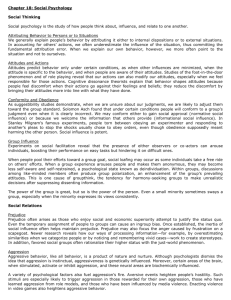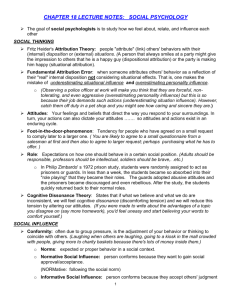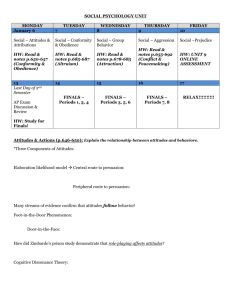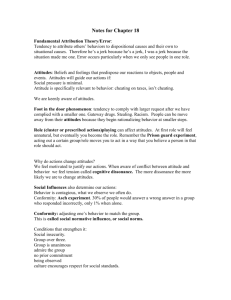Social Behavior - Gordon State College
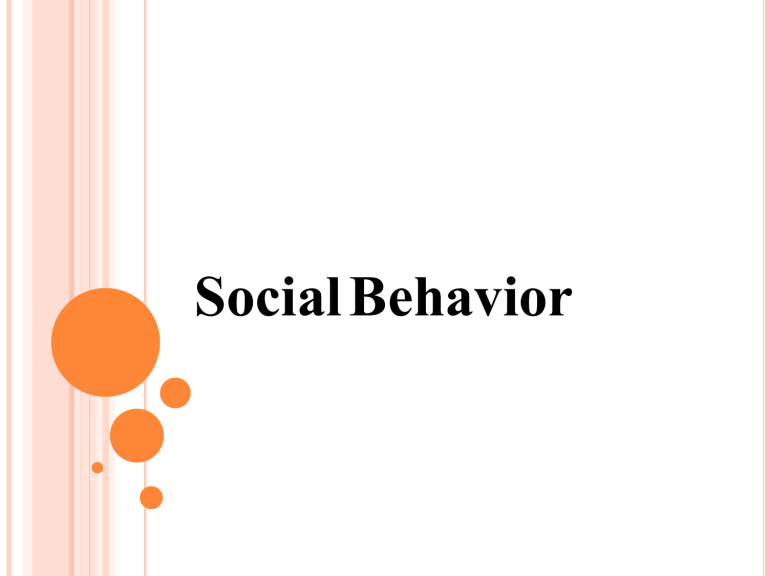
Social Behavior
S OCIAL P SYCHOLOGY
Social psychology is the scientific study of how people’s thoughts, feelings, and behavior are influenced by others.
S OCIAL P ERCEPTION
Social perception: the way we seek to understand other people and events.
Impression formation : process by which we combine various sources of information about a person into overall judgment
Attribution: process by which we use information to make inferences about the causes of behavior or events
I MPRESSION F ORMATION : F IRST W E C ATEGORIZE
P EOPLE INTO G ROUPS
Human beings are categorizing creatures.
We identify objects—including other people—according to features that distinguish them from other objects.
In social categorization, physical features such as race, sex, age, and attractiveness are most common ways to classify people, especially during first encounters.
Social categorization often occurs without conscious thought or effort.
C ATEGORIZING C AN L EAD TO S TEREOTYPING
Stereotypes: fixed ways of thinking about people that doesn’t allow for individual variation
Stereotypes are “shortcuts to thinking” that provide us with information about individuals we do not personally know.
These cognitive shortcuts also can inhibit our thinking.
E
XPLAINING
P
EOPLE
’
S
B
EHAVIOR
:
A
TTRIBUTING
M
OTIVES
Internal attribution: any explanation that locates the cause as inside the person (personality)
External attribution: any explanation that locates the cause as outside the person (situation)
E XAMPLE OF A TTRIBUTION
A TTITUDES
Attitudes are positive or negative evaluations of objects.
“Objects” include people, things, events, and issues.
When we use such words as like, dislike, love, hate, good, and bad , we are describing our attitudes
.
R
EPEATED
E
XPOSURE
S
HAPES
A
TTITUDES
Mere exposure effect: tendency to develop more positive feelings toward objects and individuals the more frequently we are exposed to them
People are more exposed to their mirrored facial images than they are to their true facial images, thus they tend to have more positive attitudes toward the former than the latter.
C
ONDITIONING
S
HAPES
A
TTITUDES
Attitudes can be formed are through operant and classical conditioning.
In operant conditioning, pleasant or unpleasant stimuli that follow a performed behavior may respectively lead to positive or negative attitudes.
In classical conditioning, attitudes may form by pairing a previously neutral stimulus with another stimulus that naturally evokes a positive or negative response in a person.
A
TTITUDE
C
HANGE
O
CCURS WITH OR WITHOUT
C
OMPREHENSION OF THE
P
ERSUASIVE
M
ESSAGE
Consciously attempting to change attitudes through the transmission of some message is called persuasion.
The elaboration likelihood model: a theory that there are two ways in which persuasive messages can cause attitude change, each differing in the amount of cognitive effort or elaboration they require
T
HE
E
LABORATION
L
IKELIHOOD
M
ODEL
:
HIGH ELABORATION
When motivated and able to think carefully about the message content, we take central route to persuasion and are influenced by strength and quality of the arguments
LOW ELABORATION
When unable or unwilling to analyze the message, we take the peripheral route to persuasion, where we pay attention to cues that are irrelevant to the content or quality of communication, such as attractiveness of communicator or sheer amount of information presented
A
TTITUDE
C
HANGE
C
AN
O
CCUR WITH OR
WITHOUT
C
OMPREHENSION OF THE
P
ERSUASIVE
M
ESSAGE
When people take peripheral route to persuasion, it isn’t important to comprehend the message:
Attitude change can occur without comprehension.
In comparison to attitudes formed through central processing, attitudes formed through peripheral processing are:
Weaker,
Less resistant to counterarguments, and
Less predictive of actual behavior.
C OGNITIVE D ISSONANCE T HEORY
L EON F ESTINGER
Leon Festinger’s cognitive dissonance theory contends that we are motivated to change our attitudes because of an internal desire to keep our attitudes and behavior consistent.
Cognitive dissonance: a feeling of discomfort caused by performing an action that is inconsistent with one’s attitudes
To relieve this feeling of discomfort, we often change our attitudes so that they are in line with our behavior.
Research suggests that expected cognitive dissonance effects are affected by cultural upbringing & underlying psychological needs.
S OCIAL I NFLUENCE
Social influence: the exercise of social power by a person or group to change the attitudes or behavior of others in a certain direction
Social power can originate from having access to certain resources or from being liked and admired by others.
The three main behavioral consequences of social influence are conformity, compliance, and obedience.
A SCH ’ S R ESEARCH : T HE P OWER OF
C ONFORMITY P RESSURE
Conformity: a yielding to perceived group pressure
Asch’s line judgment studies demonstrate that people often find it easier to conform rather than challenge the unanimous opinions of others.
A SCH ’ S L INE J UDGMENT T ASK
P
EOPLE
W
ILL
O
BEY
D
ESTRUCTIVE
O
RDERS
Obedience:
performance of an action in response to a direct order (usually from a high status person).
Milgram’s obedience research
Sixty-five percent of participants obeyed the destructive commands of an authority figure (the experimenter in a “learning study”).
Most people believe(d) they would resist the destructive commands and openly rebel.
F ACTORS T HAT I NFLUENCE O BEDIENCE TO
A UTHORITY
Source: Data from S. Milgram, Obedience to Authority: An Experimental View, Harper and Row, Publishers, Inc.,
1974; and S. Milgram, The Individual in a Social World: Essays and Experiments, Addison-Wesley Publishing
Company, 1992.
H URTING AND H ELPING O THERS
Aggression: any form of behavior intended to harm another living being
Helping: voluntary behavior that is carried out to benefit another person
A
GGRESSION
: I
NTENTION TO
H
ARM
A
NOTHER
L
IVING
B
EING
Two types of aggression:
Instrumental aggression: intention to achieve a goal
Hostile aggression: intention to cause injury or death to the victim
In some instances no clear distinctions can be made between hostile and instrumental aggression; aggression might start out instrumentally but then turn hostile.
G ENDER D IFFERENCES IN S TYLES
OF A GGRESSION
Men are more likely than women to engage in physical aggression.
They also experience physical aggression differently.
Women view their physical aggression as stress-induced, precipitated by loss of self-control, and a negative experience.
Men perceive physical aggression as exercise of control over others, provoked by challenges to their self-esteem. and a positive experience.
G ENDER D IFFERENCES IN S TYLES
OF A GGRESSION
Women more frequently engage in indirect aggression than do men:
Indirect aggression is a form of social manipulation in which the aggressor attempts to harm another person without a face-to-face encounter
G
ENDER
C
OMPARISONS IN
A
GGRESSION
B
YSTANDER
I
NTERVENTION
: D
ECIDING
TO
H
ELP
The model of bystander intervention (John
Darley and Bibb Latané) involves a series of five decisions:
1. Notice that something unusual is happening.
2. Decide whether something is wrong and help is needed.
3. Determine the extent to which one has responsibility to help.
4. Settle on the appropriate form of assistance to render.
5. Decide to carry out the helpful behavior.
T HE M ODEL OF B YSTANDER I NTERVENTION : A
F IVE -S TEP D ECISION P ROCESS
P ROXIMITY AND S IMILARITY M OST P OWERFUL F ACTORS
IN A TTRACTION
One of most powerful factors in determining whether a relationship develops with another person is his or her proximity to you.
One reason is opportunity
Another reason is familiarity
P ROXIMITY AND S IMILARITY M OST P OWERFUL F ACTORS
IN A TTRACTION
Another power factor in attraction is similarity.
The M
atching
Hypothesis says that we choose people who are similar to us.
One reason we seek similar others is for social validation.
Another reason is the desire for consistency or “balance,” in our thoughts, feelings, and social relationships. Balance is created when both parties value same things—that is, when they have similar attitudes.
A third reason is social comfort and absence of conflict.


